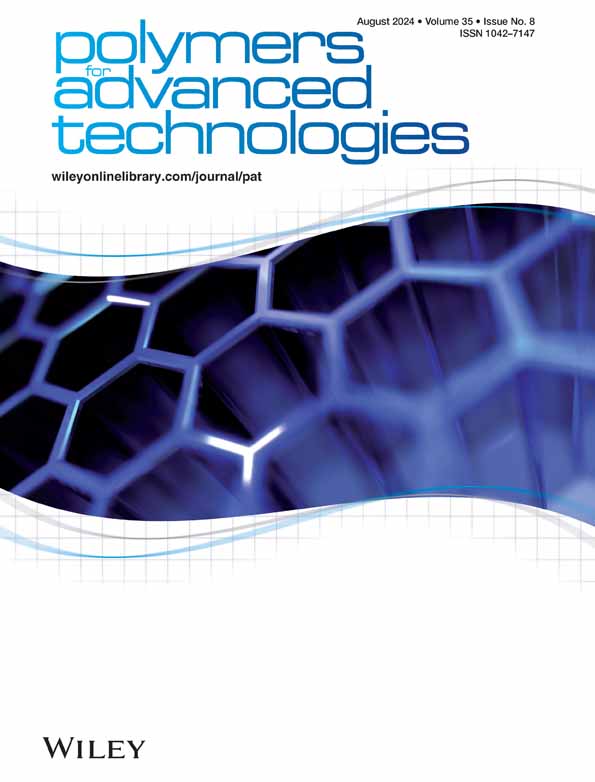Formation, structure, and morphology of nanofiber mat on the base sodium‐carboxymethylcellulose/polyvinyl‐alcohol/silver nanoparticles composite
IF 3.4
4区 工程技术
Q2 POLYMER SCIENCE
引用次数: 0
Abstract
Stable silver nanoparticles were synthesized in solutions containing sodium‐carboxymethylcellulose and polyvinyl alcohol, and their structure, morphology, and physicochemical properties were studied. The morphology and diameter sizes of the nanofibers of carboxymethylcellulose/polyvinyl alcohol containing silver nanoparticles were investigated using atomic force microscopy and scanning electron microscopy. The investigations showed that nanofibers with diameter sizes ranging from 50 to 130 nm were obtained from the carboxymethylcellulose/polyvinyl alcohol/silver nanoparticles solution. The size and form of silver nanoparticles formed within the solution of carboxymethylcellulose/polyvinyl alcohol based on nanofiber were determined by X‐ray diffraction (XRD), UV–visible (UV–VIS) spectroscopy, and dynamic light scattering (DLS) investigations, revealing nanoparticles with diameters ranging from 5 to 26 nm. The nanofiber mat containing silver nanoparticles exhibited significant antimicrobial activity against both基于羧甲基纤维素钠/聚乙烯醇/银纳米颗粒复合材料的纳米纤维毡的形成、结构和形态
在含有羧甲基纤维素钠和聚乙烯醇的溶液中合成了稳定的银纳米粒子,并对其结构、形态和理化性质进行了研究。使用原子力显微镜和扫描电子显微镜研究了含银纳米粒子的羧甲基纤维素/聚乙烯醇纳米纤维的形态和直径大小。研究结果表明,从羧甲基纤维素/聚乙烯醇/银纳米粒子溶液中得到的纳米纤维直径范围为 50 至 130 nm。通过 X 射线衍射 (XRD)、紫外-可见 (UV-VIS) 光谱和动态光散射 (DLS) 研究,确定了基于纳米纤维的羧甲基纤维素/聚乙烯醇溶液中形成的银纳米粒子的大小和形态,发现纳米粒子的直径在 5 至 26 nm 之间。含有银纳米粒子的纳米纤维毡对表皮葡萄球菌和白色念珠菌都具有显著的抗菌活性。含有稳定银纳米粒子的纳米纤维垫可用作抗菌面罩,用于过滤空气和治疗烧伤伤口。
本文章由计算机程序翻译,如有差异,请以英文原文为准。
求助全文
约1分钟内获得全文
求助全文
来源期刊

Polymers for Advanced Technologies
工程技术-高分子科学
CiteScore
6.20
自引率
5.90%
发文量
337
审稿时长
2.1 months
期刊介绍:
Polymers for Advanced Technologies is published in response to recent significant changes in the patterns of materials research and development. Worldwide attention has been focused on the critical importance of materials in the creation of new devices and systems. It is now recognized that materials are often the limiting factor in bringing a new technical concept to fruition and that polymers are often the materials of choice in these demanding applications. A significant portion of the polymer research ongoing in the world is directly or indirectly related to the solution of complex, interdisciplinary problems whose successful resolution is necessary for achievement of broad system objectives.
Polymers for Advanced Technologies is focused to the interest of scientists and engineers from academia and industry who are participating in these new areas of polymer research and development. It is the intent of this journal to impact the polymer related advanced technologies to meet the challenge of the twenty-first century.
Polymers for Advanced Technologies aims at encouraging innovation, invention, imagination and creativity by providing a broad interdisciplinary platform for the presentation of new research and development concepts, theories and results which reflect the changing image and pace of modern polymer science and technology.
Polymers for Advanced Technologies aims at becoming the central organ of the new multi-disciplinary polymer oriented materials science of the highest scientific standards. It will publish original research papers on finished studies; communications limited to five typewritten pages plus three illustrations, containing experimental details; review articles of up to 40 pages; letters to the editor and book reviews. Review articles will normally be published by invitation. The Editor-in-Chief welcomes suggestions for reviews.
 求助内容:
求助内容: 应助结果提醒方式:
应助结果提醒方式:


